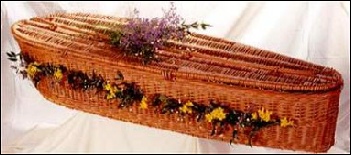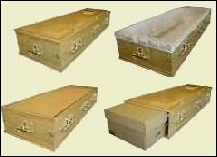
Green funerals and burials
Our death and the environment
Before the final curtain is drawn on our lives, we can make environmentally friendly choices as to how our funeral and burial is conducted.
When my mother passed away at the age of 50, it was an incredibly sad time. While I had experienced death through my work at a hospital, I had never been to a funeral -
She requested that there be no embalming, no viewing, no monuments, a simple and small service, no flowers, a very simple casket and cremation. Her ashes were spread in places she loved in Australia and around the world. People overseas held their own small services to commemorate her.
While my mother loved nature, I don't know if her decisions were environmentally motivated and I doubt so, but more that she didn't want to be a bother; bless her :). We were lucky enough to have an excellent funeral director and I learned a great deal during the process about how we treat our dead.
Death in developed countries is generally not very environmentally friendly. It's often a reflection of our lives as consumers. While a funeral is an important part of the grieving process for those of us left behind, there's much we can do to have less of an impact on the environment when we pass on.
Embalming
After we die, if our wishes are for an open casket viewing, we need to be embalmed. The following are the more invasive aspects of that process (a warning to the queasy):
1. Arterial embalming -
2. Cavity embalming -
3. Hypodermic embalming, more embalming chemicals under the skin where required.
4. Surface embalming in cases of viewable injuries.
Cosmetics may also be applied, also fragrances.
Embalming fluid is usually made up of formaldehyde, methanol and ethanol. Formaldehyde is carcinogenic and a common environmental pollutant.
Do you really wish for this to happen to your body? Is a viewing necessary? I'm not criticizing if you do; but these are aspects you may not have considered.
Caskets and coffins
Then comes the casket or coffin -
The funeral service
The funeral itself can be an elaborate and resource intensive affair with flowers, motorcades and people traveling from all points of the globe to attend. Burial is also taking up increasing amounts of land -
About cremation
Cremation has gained popularity in developing countries over the past couple of decades. It could be considered greener in many ways, but isn't without its issues; particularly if a coffin is cremated along with the deceased. A great deal of energy is needed to cremate a body. Most crematoriums no longer use coal but natural gas or propane. However, the temperatures required are around 870–980C (1,598–1,796F) and the average time is around 90 minutes. Emissions from crematories include nitrogen oxides, carbon monoxide, sulfur dioxide, mercury, hydrofluoric acid and hydrochloric acid.
Greening death
For the environmentally conscious person concerned as much about the impact of their death on nature as they are of their life; many funeral directors are recognizing this and offering green funerals and burials.
For instance, in relation to caskets there are more readily biodegradable options such as this wicker casket:
.. and this is a concept I really like -
The body is placed into a cardboard box which is then slid into the coffin cover for the service. After the service, the cardboard box is removed and buried or cremated. The cover can then be reused. This option means less trees are used for making coffins, it speeds up the decomposition process and also decreases the amount of energy needed if the remains are to be cremated.
The coffin cover not only makes good environmental sense, but also financial -
Some funerals don't take place until many days after the person has passed on. In some cultures, they must bury their dead within 24 hours -
For the service, you can state that you don't wish for flowers, but request that money that would have been spent on flowers be donated to charity. Perhaps you could also suggest the money be used for offsetting travel to the service through the purchase of green tags or carbon offsets.
As for a resting place, natural burial grounds are now springing up in many countries. These are usually woodlands, forests or reserves. Large monuments aren't permitted to be erected, just simple plaques -
Cremation alternative -
As mentioned, cremation isn't without its problems environmentally speaking -
It is supposedly an accelerated form of natural decomposition chemistry. The ash produced instead being like the color of fireplace ash, is pure white (not that it really matters). While a traditional wood coffin can't be Resomated, a coffin can act as a temporary casket and the deceased is contained in an "silk coffin" inside, which are then resomated. It's an interesting process that is still undergoing approvals in various countries -
Personally, I'm hoping that (after organ donation) what remains of me can be buried in a shroud or perhaps resomated and interred on my chunk o' dirt in the outback. I would like my ashes scattered or a native tree planted over me and I would also want the property to be turned into a heritage/nature reserve so that other kindred spirits may always be able to enjoy the peace I was privileged to experience there (well, mostly -
If there is indeed an afterlife, knowing that those wishes have been observed would certainly help me rest in peace. I'm also mentioning this as my will still isn't done -
As in life, we can approach the sensitive issue of our death with green issues close to mind. -


Copyright 2019 © San Diego Funeral Service FD 1964
OFFICE 619-